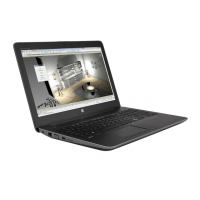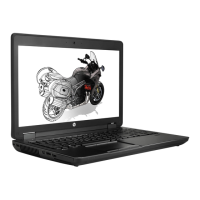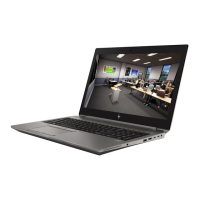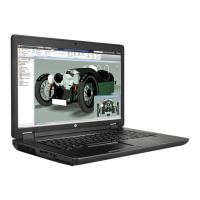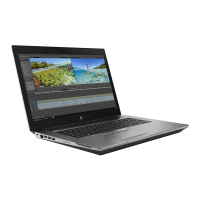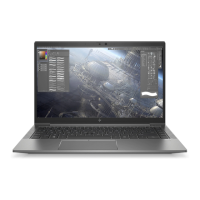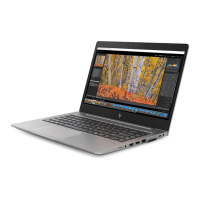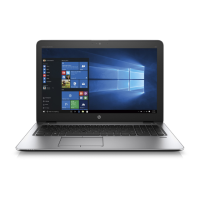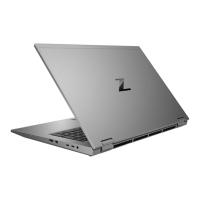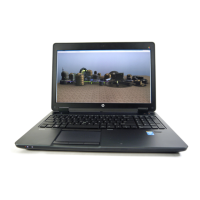
Do you have a question about the HP ZBook 15 G2 and is the answer not in the manual?
| Form factor | Clamshell |
|---|---|
| Product type | Mobile workstation |
| Product color | Black |
| Country of origin | China |
| Bus type | DMI |
| Stepping | C0 |
| Tjunction | 100 °C |
| Processor cache | 3 MB |
| Processor cores | 2 |
| Processor model | i5-4210M |
| System bus rate | 5 GT/s |
| Processor family | Intel® Core™ i5 |
| Processor series | Intel Core i5-4200 Mobile series |
| Processor socket | PGA946 |
| Processor threads | 4 |
| Processor codename | Haswell |
| Processor frequency | 2.6 GHz |
| Processor cache type | Smart Cache |
| Processor lithography | 22 nm |
| Processor manufacturer | Intel |
| Processor front side bus | - MHz |
| PCI Express slots version | 3.0 |
| Processor boost frequency | 3.2 GHz |
| Processor operating modes | 64-bit |
| ECC supported by processor | No |
| PCI Express configurations | 1x16, 2x8, 1x8+2x4 |
| Thermal Design Power (TDP) | 37 W |
| Maximum number of PCI Express lanes | 16 |
| Motherboard chipset | Intel® QM87 |
| Memory slots | 2x SO-DIMM |
| Internal memory | 4 GB |
| Memory clock speed | 1600 MHz |
| Memory form factor | SO-DIMM |
| Internal memory type | DDR3L-SDRAM |
| Maximum internal memory | 16 GB |
| Memory layout (slots x size) | 1 x 4 GB |
| HDD speed | 7200 RPM |
| HDD interface | SATA |
| Storage media | HDD |
| Optical drive type | DVD Super Multi DL |
| Card reader integrated | Yes |
| Total storage capacity | 750 GB |
| Compatible memory cards | SD, SDHC, SDXC |
| Panel type | SVA |
| Display surface | Matt |
| Display diagonal | 15.6 \ |
| Native aspect ratio | 16:9 |
| On-board graphics card ID | 0x416 |
| Discrete graphics card model | NVIDIA® Quadro® K610M |
| On-board graphics card model | Intel® HD Graphics 4600 |
| Discrete graphics card memory | 1 GB |
| Discrete graphics memory type | GDDR5 |
| On-board graphics card family | Intel® HD Graphics |
| Maximum on-board graphics card memory | 1.74 GB |
| On-board graphics card base frequency | 400 MHz |
| On-board graphics card DirectX version | 11.1 |
| Number of discrete graphics cards supported | 1 |
| On-board graphics card dynamic frequency (max) | 1150 MHz |
| Audio system | DTS Studio Sound HD |
| Front camera resolution | 1280 x 720 pixels |
| WWAN | Not installed |
| Wi-Fi standards | 802.11a, 802.11b, 802.11g |
| Bluetooth version | 4.0 |
| Ethernet LAN data rates | 10, 100, 1000 Mbit/s |
| Charging port type | DC-in jack |
| HDMI ports quantity | 0 |
| USB 2.0 ports quantity | USB 2.0 ports have a data transmission speed of 480 Mbps, and are backwards compatible with USB 1.1 ports. You can connect all kinds of peripheral devices to them. |
| USB 3.2 Gen 1 (3.1 Gen 1) Type-A ports quantity | 3 |
| Pointing device | Touchpad |
| Operating system installed | Windows 7 Professional |
| Processor code | SR1L4 |
| Processor ARK ID | 81012 |
| Intel TSX-NI version | 0.00 |
| Processor package size | 37.5 x 37.5 x 4.7 mm |
| Supported instruction sets | AVX 2.0, SSE4.1, SSE4.2 |
| Intel Identity Protection Technology version | 1.00 |
| Battery capacity | 75 Wh |
| Number of battery cells | 8 |
| AC adapter power | 150 W |
| AC adapter frequency | 50 - 60 Hz |
| AC adapter input voltage | 100 - 240 V |
| AC adapter output voltage | 19 V |
| Cable lock slot type | Kensington |
| Sustainability certificates | RoHS, EPEAT Silver, ENERGY STAR |
| Depth | 257 mm |
|---|---|
| Width | 381.5 mm |
| Height | 30.5 mm |
| Weight | 2780 g |
Lists the various Intel processors available for the workstation, including core count, clock speed, and cache.
Details the available NVIDIA Quadro and AMD FirePro graphics card options with their memory specifications.
Describes the different 15.6-inch display panel options, including resolutions and brightness.
Information about memory module slots and supported DDR3L RAM configurations.
Lists all available ports, including USB, DisplayPort, Thunderbolt, and VGA.
Details the keyboard, touchpad features, and pointing stick functionality.
Lists preinstalled and supported operating systems, including Windows and Linux options.
Identifies external display components like WLAN/WWAN antennas, microphones, and webcam.
Identifies components on the top of the laptop, including the pointing stick and touchpad.
Explains the function of various indicator lights like Power, Caps Lock, and Wireless.
Details the function of keys like Esc, Fn, Windows button, and function keys.
Identifies front-facing components and indicator lights like wireless, power, and AC adapter/battery lights.
Identifies ports and slots on the left side, including USB, Thunderbolt, and smart card reader.
Identifies bottom components like battery release latch, battery bay, SIM slot, and vents.
Explains the information found on the service tag for identification and support.
Provides an exploded view and list of major computer components with spare part numbers.
Lists spare part numbers for display bezels, panels, and webcam/microphone modules.
Lists spare part numbers for various 2.5-inch and M.2 PCIe solid-state drives and hard drives.
Lists spare part numbers for miscellaneous items like AC adapters, power cords, and cables.
Lists the tools needed for disassembly and reassembly procedures.
Provides important considerations for handling components during disassembly and reassembly.
Explains the risks of ESD and how it can affect electronic components.
Provides guidelines for safely packaging and transporting electronic equipment.
Offers recommendations for setting up and maintaining an ESD-safe workstation.
Details the procedure for removing and replacing the computer's battery.
Explains how to remove and replace the computer's hard drive.
Details the steps to remove and replace the optical drive.
Explains how to remove and replace the M.2 solid-state drive.
Explains how to update BIOS and remove/replace primary memory modules.
Lists spare part numbers and provides instructions for removing the keyboard.
Details the procedure for authorized service providers to remove the top cover.
Provides instructions for authorized service providers to remove the fan/heat sink assembly.
Provides instructions for authorized service providers to remove the processor.
Provides instructions for authorized service providers to remove the graphics board.
Provides instructions for authorized service providers to remove the display assembly.
Provides instructions for authorized service providers to remove the power connector cable.
Provides instructions for authorized service providers to remove the RJ-45 network cable.
Explains how to access and use the computer setup (BIOS) utility.
Details the steps to start the Computer Setup utility.
Guides users on how to navigate and make selections within Computer Setup.
Explains how to restore BIOS settings to factory defaults.
Provides information on updating the system's BIOS.
Guides users on how to find the current system BIOS version.
Explains the process of downloading BIOS updates from the HP website.
Introduces the MultiBoot utility for managing boot device order.
Details how to set a permanent boot order through Computer Setup.
Explains how to select a boot device for a single startup using the f9 prompt.
Describes HP Sure Start technology for BIOS protection and recovery.
Explains how to access and use the Computer Setup (BIOS) utility in Windows 8.1.
Details the steps to start the Computer Setup utility.
Guides users on how to navigate and make selections within Computer Setup.
Explains how to restore BIOS settings to factory defaults.
Provides information on updating the system's BIOS.
Guides users on how to find the current system BIOS version.
Explains the process of downloading BIOS updates from the HP website.
Introduces the MultiBoot utility for managing boot device order.
Details how to set a permanent boot order through Computer Setup.
Explains how to select a boot device for a single startup using the f9 prompt.
Describes HP Sure Start technology for BIOS protection and recovery.
Explains how to access and use Computer Setup (BIOS) in Windows 10.
Details the steps to start the Computer Setup utility for different device types.
Guides users on how to navigate and make selections within Computer Setup.
Explains how to restore BIOS settings to factory defaults.
Provides information on updating the system's BIOS.
Guides users on how to find the current system BIOS version.
Explains the process of downloading BIOS updates from the HP website.
Explains how to select a boot device for a single startup using the f9 prompt.
Details how to access and configure TPM settings in Computer Setup.
Describes HP Sure Start technology for BIOS protection and recovery.
Outlines the steps to start the HP PC Hardware Diagnostics UEFI tool.
Explains how to download the diagnostic tool to a USB drive.
Explains how to create recovery media and perform system backups.
Details the process of creating Windows 7 operating system and driver recovery DVDs.
Guides users on backing up personal files and system settings.
Describes how to perform system recovery using Windows tools or f11 recovery.
Explains how to use Windows recovery tools to restore files or system points.
Details how to use Startup Repair to fix system issues.
Explains how to use f11 recovery tools to restore the original hard drive image.
Describes how to use Windows 7 OS media for recovery if recovery media is unavailable.
Guides users on backing up information and creating system repair media in Windows 8.1.
Describes system recovery options using Windows recovery tools or f11 recovery.
Explains how to use Windows recovery tools for Automatic Repair.
Details how to use f11 recovery tools to restore the original hard drive image.
Explains how to use purchased OS media for system recovery.
Describes Windows Refresh and Reset features for system stability.
Explains how to use HP Software Setup to reinstall drivers or software.
Covers creating recovery media and backups using HP Recovery Manager and Windows tools.
Details creating HP Recovery media using HP Recovery Manager.
Explains using Windows tools for recovery and backup.
Presents options for system recovery and troubleshooting.
Guides on recovering the computer using HP Recovery Manager.
Provides essential information before starting recovery procedures.
Explains how to use HP Recovery media for system recovery.
Details how to perform system recovery using the HP Recovery partition.
Explains how to change the computer's boot order to facilitate recovery.
Guides on removing the HP Recovery partition to free up disk space.
Lists the physical and performance specifications of the computer.
Details the specifications for various hard drive models.
Explains the usage and characteristics of nonvolatile memory types in the system.
Addresses common questions related to BIOS settings and memory.
Explains HP Sure Start technology for BIOS protection and recovery.
Lists general requirements for power cord sets applicable globally.
Details country-specific requirements and accredited agencies for power cords.
